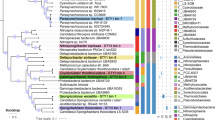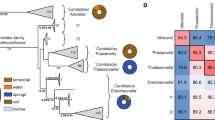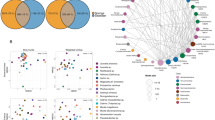Abstract
Sponges harbour complex communities of diverse microorganisms, which have been postulated to form intimate symbiotic relationships with their host. Here we unravel some of these interactions by characterising the functional features of the microbial community of the sponge Cymbastela concentrica through a combined metagenomic and metaproteomic approach. We discover the expression of specific transport functions for typical sponge metabolites (for example, halogenated aromatics, dipeptides), which indicates metabolic interactions between the community and the host. We also uncover the simultaneous performance of aerobic nitrification and anaerobic denitrification, which would aid to remove ammonium secreted by the sponge. Our analysis also highlights the requirement for the microbial community to respond to variable environmental conditions and hence express an array of stress protection proteins. Molecular interactions between symbionts and their host might also be mediated by a set of expressed eukaryotic-like proteins and cell–cell mediators. Finally, some sponge-associated bacteria (for example, a Phyllobacteriaceae phylotype) appear to undergo an evolutionary adaptation process to the sponge environment as evidenced by active mobile genetic elements. Our data clearly show that a combined metaproteogenomic approach can provide novel information on the activities, physiology and interactions of sponge-associated microbial communities.
Similar content being viewed by others
Log in or create a free account to read this content
Gain free access to this article, as well as selected content from this journal and more on nature.com
or
Accession codes
References
Alavi M, Miller T, Erlandson K, Schneider R, Belas R . (2001). Bacterial community associated with Pfiesteria-like dinoflagellate cultures. Environ Microbiol 3: 380–396.
Ashworth RB, Cormier MJ . (1967). Isolation of 2,6-dibromophenol from marine Hemichordate Balanoglossus biminiensis. Science 155: 1558–1559.
Bayer K, Schmitt S, Hentschel U . (2008). Physiology, phylogeny and in situ evidence for bacterial and archaeal nitrifiers in the marine sponge Aplysina aerophoba. Environ Microbiol 10: 2942–2955.
Boos W . (1998). Binding protein-dependent ABC transport system for glycerol 3-phosphate of Escherichia coli. Methods Enzymol 292: 40–51.
Brady A, Salzberg SL . (2009). Phymm and PhymmBL: metagenomic phylogenetic classification with interpolated Markov models. Nat Methods 6: 673–676.
Brzoska P, Rimmele M, Brzostek K, Boos W . (1994). The pho regulon-dependent Ugp uptake system for glycerol-3-phosphate in Escherichia coli is trans inhibited by Pi. J Bacteriol 176: 15–20.
Burnum KE, Callister SJ, Nicora CD, Purvine SO, Hugenholtz P, Warnecke F et al. (2011). Proteome insights into the symbiotic relationship between a captive colony of Nasutitermes corniger and its hindgut microbiome. ISME J 5: 161–164.
Chae JC, Kim Y, Kim YC, Zylstra GJ, Kim CK . (2000). Genetic structure and functional implication of the fcb gene cluster for hydrolytic dechlorination of 4-chlorobenzoate from Pseudomonas sp. DJ-12. Gene 258: 109–116.
Chen J, Ryu S, Gharib SA, Goodlett DR, Schnapp LM . (2008). Exploration of the normal human bronchoalveolar lavage fluid proteome. Proteomics Clin Appl 2: 585–595.
Ebel R, Brenzinger M, Kunze A, Gross HJ, Proksch P . (1997). Wound activation of protoxins in marine sponge Aplysina aerophoba. J Chem Ecol 23: 1451–1462.
Elssner T, Engemann C, Baumgart K, Kleber HP . (2001). Involvement of coenzyme A esters and two new enzymes, an enoyl-CoA hydratase and a CoA-transferase, in the hydration of crotonobetaine to L-carnitine by Escherichia coli. Biochemistry 40: 11140–11148.
Ezraty B, Aussel L, Barras F . (2005). Methionine sulfoxide reductases in prokaryotes. Biochim Biophys Acta 1703: 221–229.
Finn RD, Mistry J, Tate J, Coggill P, Heger A, Pollington JE et al. (2010). The Pfam protein families database. Nucleic Acids Res 38: D211–D222.
Forward JA, Behrendt MC, Wyborn NR, Cross R, Kelly DJ . (1997). TRAP transporters: a new family of periplasmic solute transport systems encoded by the dctPQM genes of Rhodobacter capsulatus and by homologs in diverse Gram-negative bacteria. J Bacteriol 179: 5482–5493.
Giovannoni S, Stingl U . (2007). The importance of culturing bacterioplankton in the ‘omics’ age. Nat Rev Microbiol 5: 820–826.
Gribble GW . (1999). The diversity of naturally occurring organobromine compounds. Chem Soc Rev 28: 335–346.
Habyarimana F, Al-Khodor S, Kalia A, Graham JE, Price CT, Garcia MT et al. (2008). Role for the ankyrin eukaryotic-like genes of Legionella pneumophila in parasitism of protozoan hosts and human macrophages. Environ Microbiol 10: 1460–1474.
Hofmann B, Hecht HJ, Flohe L . (2002). Peroxiredoxins. Biol Chem 383: 347–364.
Hoffmann F, Radax R, Woebken D, Holtappels M, Lavik G, Rapp HT et al. (2009a). Complex nitrogen cycling in the sponge Geodia barretti. Environ Microbiol 11: 2228–2243.
Hoffmann F, Radax R, Woebken D, Holtappels M, Lavik G, Rapp HT et al. (2009b). Complex nitrogen cycling in the sponge Geodia barretti. Environ Microbiol 11: 2228–2243.
Hoffmann F, Røy H, Bayer K, Hentschel U, Pfannkuchen M, Brümmer F et al. (2008). Oxygen dynamics and transport in the Mediterranean sponge Aplysina aerophoba. Mar Biol 153: 1257–1264.
Holmes B, Blanch H . (2007). Genus-specific associations of marine sponges with group I crenarchaeotes. Mar Biol 150: 759–772.
Iturbe-Ormaetxe I, Burke GR, Riegler M, O’Neill SL . (2005). Distribution, expression, and motif variability of ankyrin domain genes in Wolbachia pipientis. J Bacteriol 187: 5136–5145.
Jurado V, Laiz L, Gonzalez JM, Hernandez-Marine M, Valens M, Saiz-Jimenez C . (2005). Phyllobacterium catacumbae sp. nov., a member of the order ‘Rhizobiales’ isolated from Roman catacombs. Int J System Evoluti Microbiol 55: 1487–1490.
Kleber HP . (1997). Bacterial carnitine metabolism. FEMS Microbiol Lett 147: 1–9.
Labbe N, Parent S, Villemur R . (2004). Nitratireductor aquibiodomus gen. nov., sp. nov., a novel alpha-proteobacterium from the marine denitrification system of the Montreal Biodome (Canada). Int J Syst Evol Microbiol 54: 269–273.
Landfald B, Strom AR . (1986). Choline–glycine betaine pathway confers a high level of osmotic tolerance in Escherichia coli. J Bacteriol 165: 849–855.
Lauro FM, McDougald D, Thomas T, Williams TJ, Egan S, Rice S et al. (2009). The genomic basis of trophic strategy in marine bacteria. Proc Natl Acad Sci USA 106: 15527–15533.
Letoffe S, Delepelaire P, Wandersman C . (2006). The housekeeping dipeptide permease is the Escherichia coli heme transporter and functions with two optional peptide binding proteins. Proc Natl Acad Sci USA 103: 12891–12896.
Liu MY, Kjelleberg S, Thomas T . (2011). Functional genomic analysis of an uncultured delta-proteobacterium in the sponge Cymbastela concentrica. ISME J 5: 427–435.
Liu YH, Yang B, Dong JD, Zhou XF, Yang XW, Lee KJ et al. (2009). Proline-containing dipeptides from a marine sponge of a Callyspongia species. Helv Chim Acta 92: 1112–1117.
Mantelin S, Saux MF, Zakhia F, Bena G, Bonneau S, Jeder H et al. (2006). Emended description of the genus Phyllobacterium and description of four novel species associated with plant roots: Phyllobacterium bourgognense sp. nov., Phyllobacterium ifriqiyense sp. nov., Phyllobacterium leguminum sp. nov. and Phyllobacterium brassicacearum sp. nov. Int J Syst Evolut Microbiol 56: 827–839.
Marchler-Bauer A, Lu S, Anderson JB, Chitsaz F, Derbyshire MK, DeWeese-Scott C et al. (2011). CDD: a Conserved Domain Database for the functional annotation of proteins. Nucleic Acids Res 39: D225–D229.
Mavromatis K, Doyle CK, Lykidis A, Ivanova N, Francino MP, Chain P et al. (2006). The genome of the obligately intracellular bacterium Ehrlichia canis reveals themes of complex membrane structure and immune evasion strategies. J Bacteriol 188: 4015–4023.
Mergaert J, Boley A, Cnockaert MC, Muller WR, Swings J . (2001). Identity and potential functions of heterotrophic bacterial isolates from a continuous-upflow fixed-bed reactor for denitrification of drinking water with bacterial polyester as source of carbon and electron donor. System Aappl Microbiol 24: 303–310.
Mohamed NM, Saito K, Tal Y, Hill RT . (2010). Diversity of aerobic and anaerobic ammonia-oxidizing bacteria in marine sponges. ISME J 4: 38–48.
Morris RM, Nunn BL, Frazar C, Goodlett DR, Ting YS, Rocap G . (2010). Comparative metaproteomics reveals ocean-scale shifts in microbial nutrient utilization and energy transduction. ISME J 4: 673–685.
Morris RM, Rappe MS, Connon SA, Vergin KL, Siebold WA, Carlson CA et al. (2002). SAR11 clade dominates ocean surface bacterioplankton communities. Nature 420: 806–810.
Mulligan C, Fischer M, Thomas GH . (2011). Tripartite ATP-independent periplasmic (TRAP) transporters in bacteria and archaea. FEMS Microbiol Rev 35: 68–86.
Ng C, DeMaere MZ, Williams TJ, Lauro FM, Raftery M, Gibson JA et al. (2010). Metaproteogenomic analysis of a dominant green sulfur bacterium from Ace Lake, Antarctica. ISME J 4: 1002–1019.
Nichols NN, Harwood CS . (1995). Repression of 4-hydroxybenzoate transport and degradation by benzoate: a new layer of regulatory control in the Pseudomonas putida beta-ketoadipate pathway. J Bacteriol 177: 7033–7040.
Norte M, Rodriguez ML, Fernandez JJ, Eguren L, Estrada DM . (1988). Aplysinadiene and (R,R) 5 [3,5-dibromo-4-[(2-oxo-5-oxazolidinyl)] methoxyphenyl]-2-oxazolidinone, 2 novel metabolites from Aplysina–Aerophoba—synthesis of Aplysinadiene. Tetrahedron 44: 4973–4980.
Nummelin H, Merckel MC, Leo JC, Lankinen H, Skurnik M, Goldman A . (2004). The Yersinia adhesin YadA collagen-binding domain structure is a novel left-handed parallel beta-roll. EMBO J 23: 701–711.
Olson ER, Dunyak DS, Jurss LM, Poorman RA . (1991). Identification and characterization of dppA, an Escherichia coli gene encoding a periplasmic dipeptide transport protein. J Bacteriol 173: 234–244.
Overbeek R, Begley T, Butler RM, Choudhuri JV, Chuang HY, Cohoon M et al. (2005). The subsystems approach to genome annotation and its use in the project to annotate 1000 genomes. Nucleic Acids Res 33: 5691–5702.
Pedersen M, Saenger P, Fries L . (1974). Simple brominated phenols in red algae. Phytochemistry 13: 2273–2279.
Perry JJ, Shin DS, Getzoff ED, Tainer JA . (2010). The structural biochemistry of the superoxide dismutases. Biochim Biophys Acta 1804: 245–262.
Poolman B, Konings WN . (1993). Secondary solute transport in bacteria. Biochim Biophys Acta 1183: 5–39.
Preusser A, Wagner U, Elssner T, Kleber HP . (1999). Crotonobetaine reductase from Escherichia coli consists of two proteins. Biochim Biophys Acta 1431: 166–178.
Ram RJ, Verberkmoes NC, Thelen MP, Tyson GW, Baker BJ, Blake II RC et al. (2005). Community proteomics of a natural microbial biofilm. Science 308: 1915–1920.
Schaffer S, Isci N, Zickner B, Durre P . (2002). Changes in protein synthesis and identification of proteins specifically induced during solventogenesis in Clostridium acetobutylicum. Electrophoresis 23: 110–121.
Schauer K, Rodionov DA, de Reuse H . (2008). New substrates for TonB-dependent transport: do we only see the ‘tip of the iceberg’? Trends Biochem Sci 33: 330–338.
Schlappy ML, Schottner SI, Lavik G, Kuypers MMM, de Beer D, Hoffmann F . (2010). Evidence of nitrification and denitrification in high and low microbial abundance sponges. Mar Biol 157: 593–602.
Schmidt EW, Obraztsova AY, Davidson SK, Faulkner DJ, Haygood MG . (2000). Identification of the antifungal peptide-containing symbiont of the marine sponge Theonella swinhoei as a novel delta-proteobacterium, ‘Candidatus Entotheonella palauensis’. Mar Biol 136: 969–977.
Schmidt II, Bock E . (1997). Anaerobic ammonia oxidation with nitrogen dioxide by Nitrosomonas eutropha. Arch Microbiol 167: 106–111.
Schmitz FJ, Gopichand Y . (1978). (7e, 13-Xi, 15z)-14,16-dibromo-7,13,15-hexadecatrien-5-ynoic acid—novel dibromo acetylenic acid from marine sponge Xestospongia muta. Tetrahedron Lett 19: 3637–3640.
Sowell SM, Abraham PE, Shah M, Verberkmoes NC, Smith DP, Barofsky DF et al. (2011). Environmental proteomics of microbial plankton in a highly productive coastal upwelling system. ISME J 5: 856–865.
Sowell SM, Wilhelm LJ, Norbeck AD, Lipton MS, Nicora CD, Barofsky DF et al. (2009). Transport functions dominate the SAR11 metaproteome at low-nutrient extremes in the Sargasso Sea. ISME J 3: 93–105.
Tatusov RL, Fedorova ND, Jackson JD, Jacobs AR, Kiryutin B, Koonin EV et al. (2003). The COG database: an updated version includes eukaryotes. BMC Bioinform 4: 41.
Taylor MW, Radax R, Steger D, Wagner M . (2007). Sponge-associated microorganisms: evolution, ecology, and biotechnological potential. Microbiol Mol Biol Rev 71: 295–347.
Thomas T, Rusch D, DeMaere MZ, Yung PY, Lewis M, Halpern A et al. (2010). Functional genomic signatures of sponge bacteria reveal unique and shared features of symbiosis. ISME J 4: 1557–1567.
Ullmann R, Gross R, Simon J, Unden G, Kroger A . (2000). Transport of C(4)-dicarboxylates in Wolinella succinogenes. J Bacteriol 182: 5757–5764.
Unson MD, Holland ND, Faulkner DJ . (1994). A brominated secondary metabolite synthesized by the cyanobacterial symbiont of a marine sponge and accumulation of the crystalline metabolite in the sponge tissue. Mar Biol 119: 1–11.
Utkina NK, Denisenko VA, Scholokova OV, Virovaya MV, Gerasimenko AV, Popov DY et al. (2001). Spongiadioxins A and B, two new polybrominated dibenzo-p-dioxins from an Australian marine sponge Dysidea dendyi. J Nat Prod 64: 151–153.
Vogel S . (1977). Current-induced flow through living sponges in nature. Proc Natl Acad Sci USA 74: 2069–2071.
Voth DE, Howe D, Beare PA, Vogel JP, Unsworth N, Samuel JE et al. (2009). The Coxiella burnetii ankyrin repeat domain-containing protein family is heterogeneous, with C-terminal truncations that influence Dot/Icm-mediated secretion. J Bacteriol 191: 4232–4242.
Vuilleumier S . (1997). Bacterial glutathione S-transferases: what are they good for? J Bacteriol 179: 1431–1441.
Walker CB, de la Torre JR, Klotz MG, Urakawa H, Pinel N, Arp DJ et al. (2010). Nitrosopumilus maritimus genome reveals unique mechanisms for nitrification and autotrophy in globally distributed marine crenarchaea. Proc Natl Acad Sci USA 107: 8818–8823.
Walt A, Kahn ML . (2002). The fixA and fixB genes are necessary for anaerobic carnitine reduction in Escherichia coli. J Bacteriol 184: 4044–4047.
Webster NS, Blackall LL . (2008). What do we really know about sponge–microbial symbioses? ISME J 3: 1–3.
Webster NS, Cobb RE, Negri AP . (2008). Temperature thresholds for bacterial symbiosis with a sponge. ISME J 2: 830–842.
Webster NS, Taylor MW . (2011). Marine sponges and their microbial symbionts: love and other relationships. Environ Microbiol; epub ahead of print 28 March 2011; doi: 10.1111/j.1462-2920.2011.02460.x.
White RH, Hager LP . (1977). Occurrence of fatty-acid chlorohydrins in jellyfish lipids. Biochemistry 16: 4944–4948.
Wilkinson CR . (1983). Net primary productivity in coral reef sponges. Science 219: 410–412.
Wilmes P, Wexler M, Bond PL . (2008). Metaproteomics provides functional insight into activated sludge wastewater treatment. PLoS One 3: e1778.
Zhu P, Li Q, Wang G . (2008). Unique microbial signatures of the alien Hawaiian marine sponge Suberites zeteki. Microb Ecol 55: 406–414.
Acknowledgements
We acknowledge the J. Craig Venter Institute (JCVI) Joint Technology Center under the leadership of Yu-Hui Rogers and the assistance of Matt Lewis for producing the sequencing data. This work was supported by funding from the Gordon and Betty Moore Foundation and the Australian Research Council (LP0668235).
Author information
Authors and Affiliations
Corresponding author
Additional information
Supplementary Information accompanies the paper on The ISME Journal website
Supplementary information
Rights and permissions
About this article
Cite this article
Liu, M., Fan, L., Zhong, L. et al. Metaproteogenomic analysis of a community of sponge symbionts. ISME J 6, 1515–1525 (2012). https://doi.org/10.1038/ismej.2012.1
Received:
Revised:
Accepted:
Published:
Issue date:
DOI: https://doi.org/10.1038/ismej.2012.1
Keywords
This article is cited by
-
Exploring Prokaryotic Communities in the Guts and Mucus of Nudibranchs, and Their Similarity to Sediment and Seawater Microbiomes
Current Microbiology (2023)
-
Ammonia-oxidizing archaea in biological interactions
Journal of Microbiology (2021)
-
Integrating novel tools to elucidate the metabolic basis of microbial symbiosis in reef holobionts
Marine Biology (2021)
-
Fueled by methane: deep-sea sponges from asphalt seeps gain their nutrition from methane-oxidizing symbionts
The ISME Journal (2019)
-
Changes in the metabolic potential of the sponge microbiome under ocean acidification
Nature Communications (2019)



